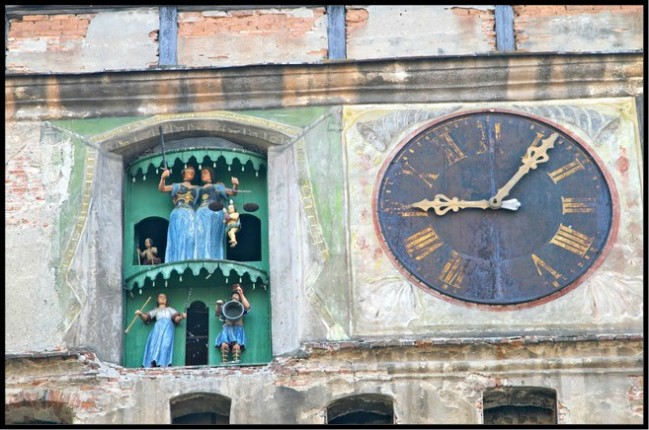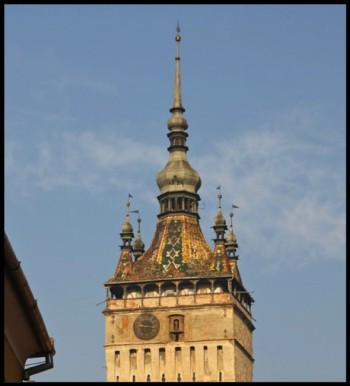
The Clock Tower, or Council Tower, is the most imposing and impressive of Sighisoara’s towers and the one though which the majority of visitors enter and leave the Citadel area.
Situated in the middle of the southern fortification wall, it protected the stairway connecting the upper town and the lower town, was home to the town’s council until 1556 and served as the archive and treasury for Sighisoara. It was from here that sentences of execution were delivered with actual executions often being carried out on the nearby main square. The four turrets on the top of the tower symbolise the judicial autonomy of the town and in particular its jus gladii (right of the sword or the right to administer capital punishment).
The tower was built in the 14th century and reached its current height of 64m in the 16th century. In 1676 the tower was badly damaged in a fire resulting from the explosion of much of the towns supply of gunpowder which was stored in Tailors Tower. The fire destroyed about three quarters of the lower town though most of the Citadel buildings survived albeit with some damage. The tower’s roof was restored in 1677 in its present Baroque style by Austrian artists and the colourful enamelled roof tiles were added in 1894.
The spire of the tower ends in a small golden sphere. At the top, there is a meteorological cock.

While the Clock Tower itself was built in the 14th century it wasn’t until the 17th century that its absolutely stunning two plate (face) clock was added. One dial faces the Lower Town while the other faces the citadel. For a sense of scale the clock faces are 2.4m in diameter.

The current clock, built in 1648 by Johann Kirchel, features fairly rough though beautiful Baroque linden wood figurines and replaces another 1604 wooden clock. There is some debate as to the date of the figurines which may in fact date from 1677, earlier ones having been destroyed in the fire I referred to earlier which ravaged much the Lower Town in 1646.
The figurines, moved by the clock’s mechanism, each represent a different character. On the citadel side (Pictured above) you can see Peace holding an olive branch, accompanied by a drummer who is beating the hours on his bronze drum; above them are Justice, with a set of scales, and Law, wielding a sword, accompanied by two angels representing Day and Night. At 6 am, the angel symbolising the day appears, marking the beginning of the working day and at 6 pm, the angel symbolising the night comes out carrying two burning candles, marking the end of the working day.

The dial overlooking the Lower City (above) features a set of seven 0.8m figurines, each representing the pagan gods who personified the days of the week: Diane (Monday), Mars (Tuesday), Mercury (Wednesday), Jupiter (Thursday), Venus (Friday), Saturn (Saturday)and the Sun (Sunday).  While a little hard to make out from the attached we visited on a Sunday – as represented by a woman in a blue coat and red skirt, which has golden sun rays around her head. The lower figurines on this side of the clock are an executioner and another drummer.
While a little hard to make out from the attached we visited on a Sunday – as represented by a woman in a blue coat and red skirt, which has golden sun rays around her head. The lower figurines on this side of the clock are an executioner and another drummer.
The clock’s internal workings form part of the History Museum and can be seen just before you go out onto the balcony at the top of the Tower. The current clock mechanism was made by Fuchs from Switzerland and was installed in the Clock Tower on April 1, 1906 and upgraded to an electric mechanism in 1964.
The Clock Tower museums (there were three three in 2013) are all covered by one combined ticket. I can only comment on the History Museum – the main one within the Clock Tower – as the Torture Chamber Museum and the Museum of Medieval Arms were closed when I visited.
My motivation (as I suspect is the case for a lot of people) for going into the History Museum was twofold. Firstly to see the views from the top of the Clock Tower(which houses the Museum) and secondly to see the mechanisms of the Clock Tower’s Clock.
Having said that the museum is reasonably interesting in itself so, while you are making your way up the tower, do have a look at some of the exhibits along the way. Doing so also provides a convenient excuse (without embarrassment) for numerous rests on the climb.
The museum is entered from the citadel side of the tower and tickets are obtained from the ground floor level which also hosts a small gift shop. On the next level you will find an archaeological display containing local exhibits dating from around 2000BC. Next comes a small furniture display (1700s).
On the second floor is the Pharmacy Hall wherein you will find, amongst other things, a collection of surgical instruments including knives and saws, and enema syringes which may make your eyes water and/or think you have accidentally strayed into the Torture Chamber Museum.
Onward and upward you will come across a rustic 1536 wooden door and pass some Renaissance furniture before you ascend the Tower’s famous spiral ladder to reach the Guild’s Hall on the fourth floor. Around 15 craft guilds played a key role in the foundation and construction of the Citadel. See my general tip on the Citadel for more details on the Guilds.
After passing some ceramics you will reach the fifth floor, which houses a timepiece display, and the mechanisms of the Clock Tower’s Clock. Having lingered here a little it’s out onto the balcony for some quite beautiful views of the Lower Town and the Citadel. Polished metal plaques and other markers indicate distances to various capitals around the world. In case you are wondering, from here it is 3975kms to the North Pole.
The accompanying Lower Town photos are taken from the balcony. I have posted a couple of Citadel views on my general Citadel tip.
Tower/History Museum Opening hours – Seasonal. Closed Mon. (Sept 2017 note: A former website address I had for the museum no longer works and I cannot find an alternative –
Admission charge :10 ron (2013) plus a hefty premium to take photographs – hence the absence of internal photos.
This entry is one of a group (loop) of entries on Sighisoara, Romania. I suggest you continue with my next entry – HERE – or to start the loop at the beginning go to my introductory entry – HERE.









These views would seem to be decent substitutes fr the as-yet unforthcoming offer of a helicopter 😉 I’m always pleased too when I have the opportunity to take an unembarrassing break on a long climb, or better still, several!
LikeLiked by 1 person
Now this was the skyscraper of the times!
LikeLiked by 1 person
Only 3975 km to the North Pole.
LikeLike